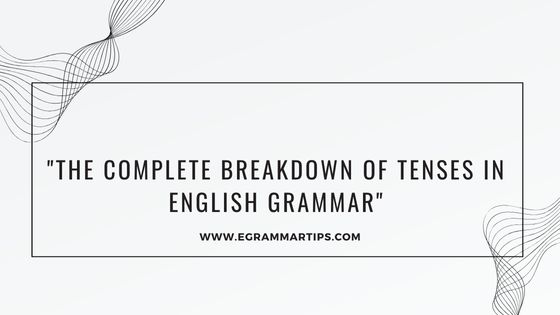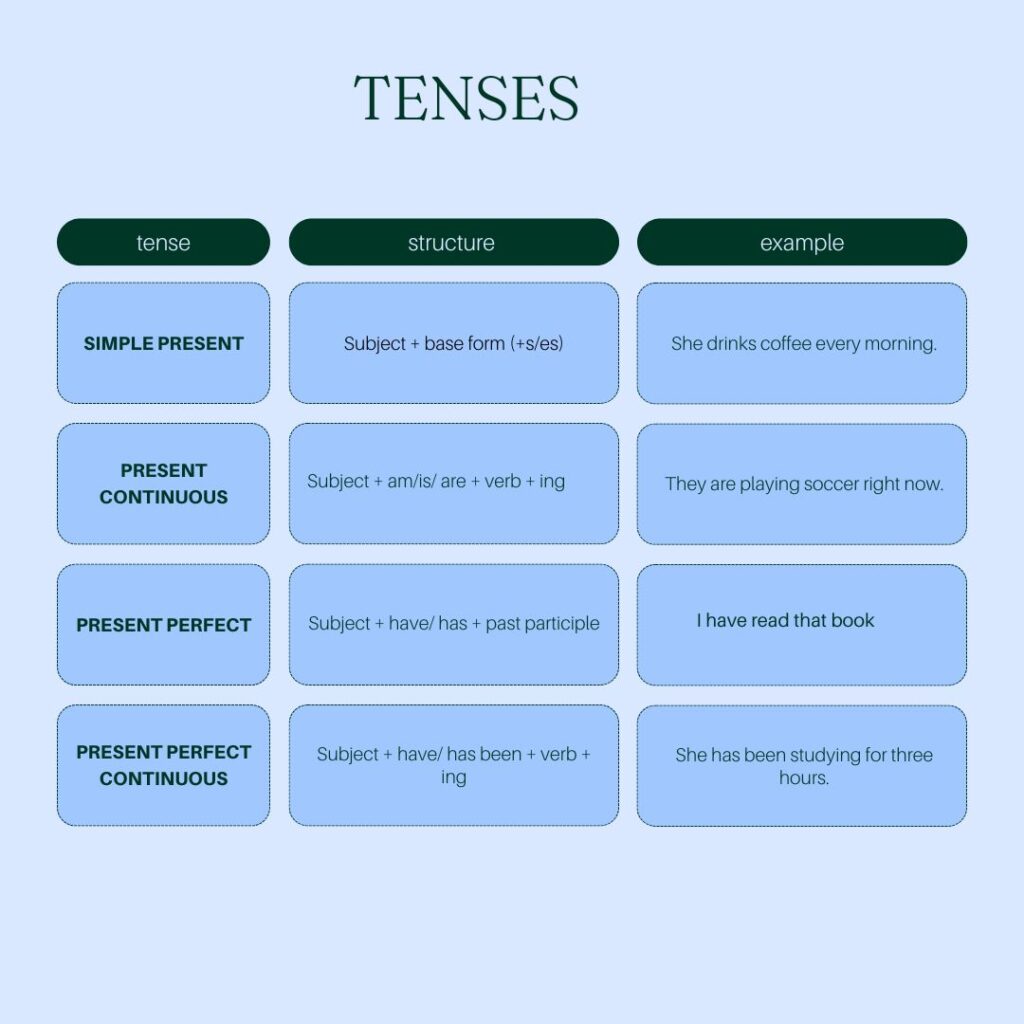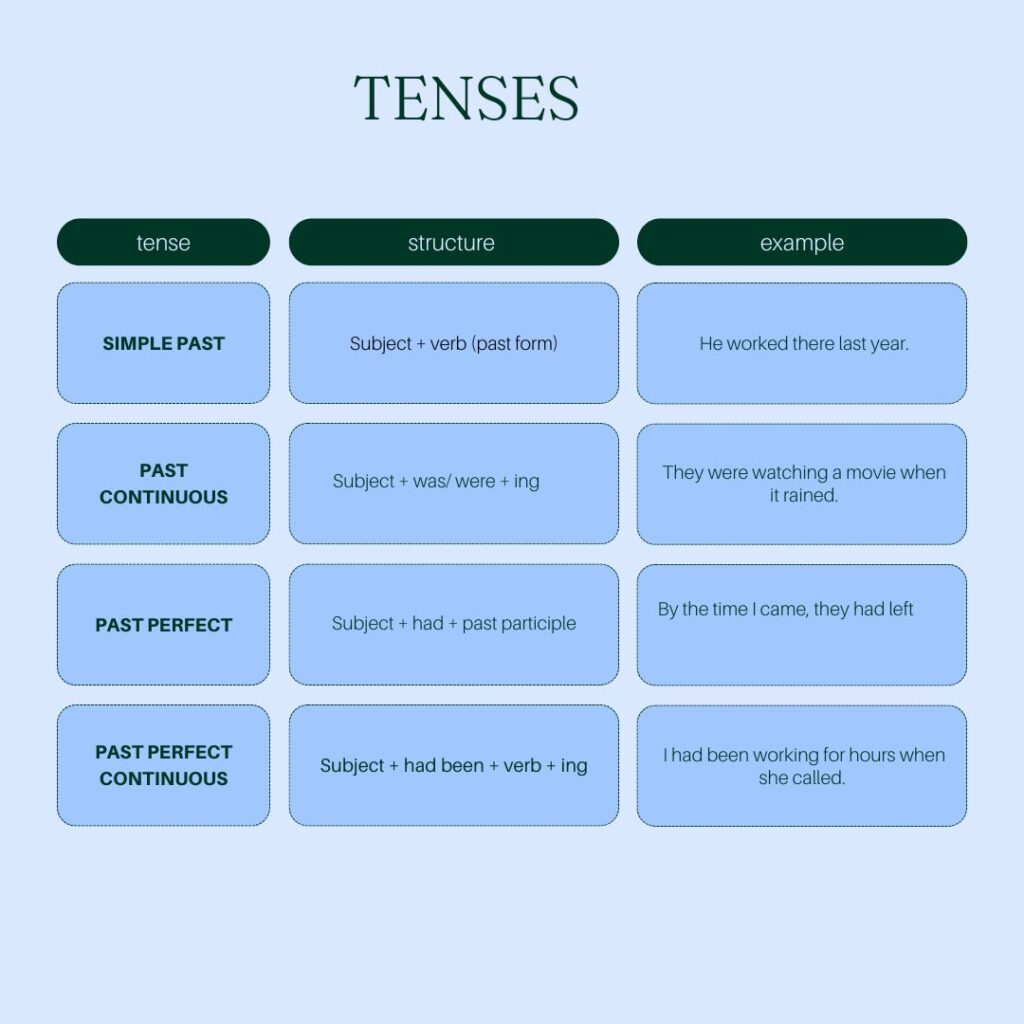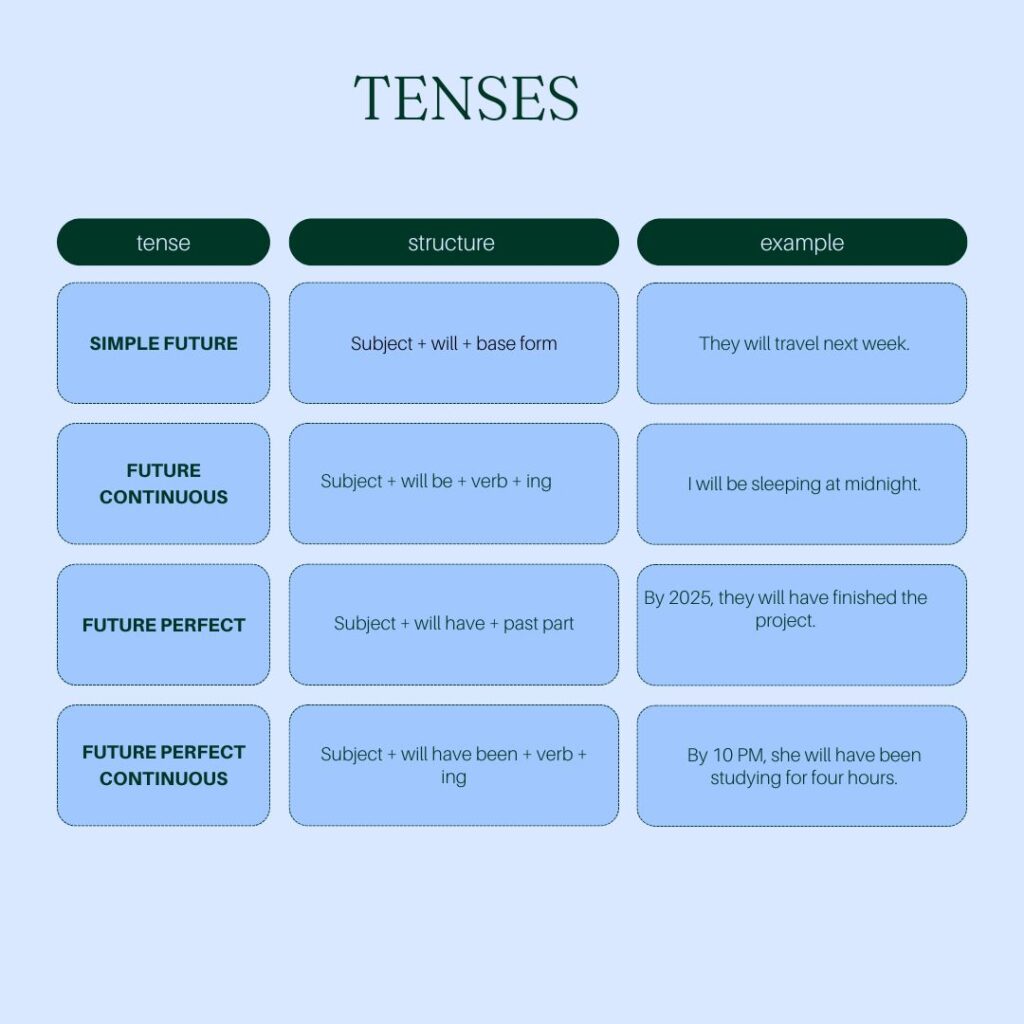
Tenses are fundamental to understanding and using English, as they indicate when an action occurs. There are three primary tenses in English—Present, Past, and Future—each with four aspects: Simple, Continuous (Progressive), Perfect, and Perfect Continuous. Each aspect adds layers of meaning to how an action relates to time.



1. Present Tense
The present tense is used for actions that are happening now, habitual actions, or truths. There are four forms of the present tense ;
a. Simple Present
Structure: Subject + base form of the verb (+s/es for third person singular)
Explanation:The simple present is used to express general truths, habitual actions, and repeated events. It does not indicate ongoing or continuous actions.
Third Person Singular Rule: For third person singular subjects (he, she, it), an “s” or “es” is added to the base verb.
Example:
• “He runs every day.”
This sentence implies that running is a regular activity.
Usage in Depth:
Habitual actions:
•”She works out every morning.”
This indicates a regular, repeated activity.
Scheduled events (near future):
• “The bus arrives at 8 AM.”
For fixed schedules or timetables.
Universal truths:
•”Water boils at 100°C.”
Statements that are always true regardless of time or place.
b. Present Continuous
Structure: Subject + am/is/are + verb + ing
Explanation:The present continuous describes actions that are happening right now or temporary actions that are in progress.It is also used for planned future actions.
Example: “She is reading a book.”This shows that the action is ongoing and not yet completed.
Usage in Depth:
Actions happening now:
•“They are watching a movie right now.”
Refers to something ongoing at the moment of speaking.
Temporary actions:
•”I am living with my parents these days.”
Shows a situation that is not permanent but is in progress for now.
Future plans:
•”We are meeting our friends tomorrow.”
Indicates a future event already arranged.
c. Present Perfect
Structure:
Subject + have/has + past participle
Explanation:The present perfect tense links past actions or states with the present. It emphasizes the result of an action, not when it occurred.It’s often used with adverbs like “just,” “already,” “yet,” and “ever.”
Example: “I have finished my homework.”
The action is completed, and the emphasis is on the result (homework is done).
Usage in Depth:Actions that happened at an unspecified time:
•”She has visited Paris.”
We don’t know exactly when, but the experience is important.
Actions that started in the past and continue to the present:
•”We have lived here for five years.”
The living started in the past and is still ongoing.
Actions with relevance to the present:
• “I have lost my keys.”
The loss occurred in the past, but the consequence (not having the keys) is felt now.
d. Present Perfect Continuous
Structure: Subject + have/has been + verb + ing
Explanation:This tense emphasizes duration—an action that started in the past and is either continuing into the present or has recently stopped with a noticeable effect on the present.
Example:
•”She has been studying for three hours.”
The action of studying began in the past and continues into the present.
Usage in Depth:
Continuous actions from past to present:
• “They have been living here since 2010.”
Stresses the duration of the action.
Recently finished actions:
• “You look tired. Have you been running?”
The running may have stopped, but its effects (being tired) are still evident.
2. Past Tense
The past tense deals with actions or states that occurred at a specific time in the past. Like the present tense, the past tense also has four aspects.
a. Simple Past
Structure: Subject + verb (past form)
Explanation:The simple past expresses completed actions at a definite time in the past. The exact time of the action may or may not be mentioned, but it’s understood that the action is over.
Example:
• “She visited her grandmother yesterday.”
The action of visiting happened in the past and is now completed.
Usage in Depth:Completed actions in the past:
•”I saw that movie last week.”
The movie-watching is over and done with.Actions that happened at a specific time:
•”They moved here in 2020.”
The action occurred at a definite point in the past.
b. Past Continuous
Structure:
Subject + was/were + verb + ing
Explanation:This tense describes actions that were ongoing at a specific point in the past. It often shows an action interrupted by another event.
Example: “I was reading when she called.”
The reading was in progress when another action (the call) occurred.
Usage in Depth:
Interrupted actions:
•”He was sleeping when the alarm rang.”
The action of sleeping was interrupted by the alarm.
Simultaneous past actions:
•”She was cooking while he was cleaning.”
Two actions were happening at the same time in the past.
c. Past Perfect
Structure: Subject + had + past participle
Explanation:The past perfect indicates an action that was completed before another action in the past. It’s used to show the sequence of events.
Example:
“By the time I arrived, she had left.”
The leaving occurred before the arriving.
Usage in Depth:
Completed actions before another past event:
•”When we got to the theater, the movie had already started.”
The movie started before the arrival.
d. Past Perfect Continuous
Structure: Subject + had been + verb + ing
Explanation:This tense emphasizes the duration of an action that was happening before another action or point in the past.
Example:
• “He had been working for two hours before she arrived.”
The working was happening over a period of time and finished just before the arrival.
Usage in Depth:
Actions happening before a specific past time:
•”They had been living in New York for five years before moving to London.”
This emphasizes the length of time spent in New York before the move.
3. Future Tense
The future tense describes actions that will happen at a later time. Like the present and past, the future tense has four aspects.
a. Simple Future
Structure: Subject + will/shall + base form of the verb
Explanation:The simple future describes actions that are expected to happen in the future. It’s often used for predictions, promises, or decisions made at the moment.
Example:
• “They will travel to Japan next year.”
The traveling is expected to happen in the future.
Usage in Depth:
Predictions:
• “It will rain tomorrow.”
Based on information, a prediction is made about a future event.
Spontaneous decisions:
•”I will help you with that.”
A decision made in the moment.
Promises:
• “I will call you later.”
A promise to take future action.
b. Future Continuous
Structure: Subject + will be + verb + ing
Explanation:The future continuous is used for actions that will be ongoing at a specific point in the future.
Example:
•”This time tomorrow, I will be flying to London.”
At a certain future point, the action of flying will be in progress.
Usage in Depth:
Actions in progress in the future:
• “Next week at this time, I will be attending a conference.”
Describes an action in progress at a specific future time.
c. Future Perfect
Structure: Subject + will have + past participle
Explanation:The future perfect describes an action that will be completed by a specific future time.
Example:
•”By next year, I will have graduated from college.”
The graduation will be completed by the specified future time.
Usage in Depth:
Completed actions before a specific future time:
• “By 2025, they will have finished building the new bridge.”
Describes an action that will be completed before or by a particular time in the future. The action is viewed as completed when that time arrives.
d. Future Perfect Continuous
Structure: Subject + will have been + verb + ing
Explanation:The future perfect continuous focuses on the duration of an action that will be happening up until a specific point in the future. It highlights how long an action has been in progress by the time of a future moment.
Example:
• “By next month, she will have been working here for five years.”
Emphasizes that by the future point (next month), the action (working) will have been ongoing for a specific period (five years).
Usage in Depth:
Duration of an action up until a future point:
• “By 10 PM, I will have been studying for four hours.”
The studying will have been continuing for four hours by 10 PM. The focus is on the period leading up to that moment.
Ongoing actions with a future deadline:
• “By the time we reach the station, we will have been traveling for six hours.”
This shows that the travel will have been in progress for a long time before reaching the station.
Key Takeaways:
Simple tenses describe completed or regular actions.
Continuous tenses describe ongoing actions at a specific time.
Perfect tenses focus on the completion of actions relative to other times.
Perfect continuous tenses emphasize the duration of actions.
Understanding these tenses helps you express ideas clearly about when actions happen, whether they are completed, ongoing, or related to other events in time.